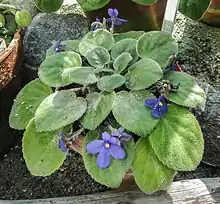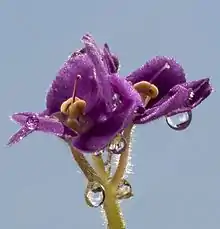Streptocarpus sect. Saintpaulia
Streptocarpus sect. Saintpaulia is a section within Streptocarpus subgenus Streptocarpella[1] consisting of about ten species of herbaceous perennial flowering plants in the family Gesneriaceae, native to Tanzania and adjacent southeastern Kenya in eastern tropical Africa. The section was previously treated as a separate genus, Saintpaulia, but molecular phylogenetic studies showed that it was nested within the genus Streptocarpus.
| Streptocarpus sect. Saintpaulia | |
|---|---|
 | |
| Streptocarpus teitensis in cultivation | |
| Scientific classification | |
| Kingdom: | Plantae |
| Clade: | Tracheophytes |
| Clade: | Angiosperms |
| Clade: | Eudicots |
| Clade: | Asterids |
| Order: | Lamiales |
| Family: | Gesneriaceae |
| Genus: | Streptocarpus |
| Subgenus: | S. subg. Streptocarpella |
| Section: | S. sect. Saintpaulia H.Wendl. |
| Species | |

Species and cultivars are commonly called African violets (although they are not closely related to true violets) or saintpaulias. They are commonly used as indoor houseplants, but can also be kept as outdoor plants in certain climates.
Several of the species and subspecies of the section are endangered, and many more are threatened, as their native cloud forest habitats are cleared for agriculture. The conservation status of Streptocarpus ionanthus has been classed as near-threatened.
Description
Saintpaulias, which grow from 6–15 cm tall, can be anywhere from 6–30 cm wide. The leaves are rounded to oval, 2.5–8.5 cm long with a 2–10 cm petiole, finely hairy, and have a fleshy texture. The flowers are 2–3 cm in diameter, with a five-lobed velvety corolla ("petals"), and grow in clusters of 3–10 or more on slender stalks called peduncles. Wild species can have violet, purple, pale blue, or white flowers.[2]
The plants get their common name "African violet" from their superficial resemblance to true violets (Viola, family Violaceae).
Taxonomy
The section was initially regarded as a separate genus. Baron Walter von Saint Paul-Illaire (1860–1940) was the district commissioner of Tanga province when he discovered the plant in Tanganyika (now Tanzania) in Africa in 1892 and sent seeds back to his father, an amateur botanist in Germany. The genus was named for Saint Paul-Illaire and his father.[3] Two British plant enthusiasts, Sir John Kirk and the Reverend W.E. Taylor, had earlier collected and submitted specimens to the Royal Botanic Gardens, Kew, in 1884 and 1887 respectively, but the quality of specimens was insufficient to permit scientific description at that time. The genus Saintpaulia, and original species S. ionantha, were scientifically described by H. Wendland in 1893.[4]
Revisions of the genus by B.L. Burtt expanded the genus to approximately 20 species. Following studies which showed most of the species to be very poorly differentiated, both genetically and morphologically, the number of species was reduced to six in a 2006 treatment, with the majority of former species reduced to subspecies under S. ionantha.[5] In 2009, 9 species, 8 subspecies, and 2 varieties were recognized.[6]
A molecular phylogenetic study in 2015 confirmed previous studies showing that species placed in Saintpaulia were deeply embedded within the genus Streptocarpus,[7] supporting the transfer of all Saintpaulia species to Streptocarpus in 2012.[8] Former Saintpaulia species did form a monophyletic group, and were placed in section Saintpaulia of Streptocarpus subgenus Streptocarpella.[7]
Species
All the species previously placed in the genus Saintpaulia are now placed in Streptocarpus section Saintpaulia. Ten species were recognized, as of March 2020.[7][9]
- Streptocarpus afroviola Christenh.
- Streptocarpus albus (E.A.Bruce) I.Darbysh.
- Streptocarpus brevipilosus (B.L.Burtt) Mich.Möller & Haston
- Streptocarpus goetzeanus (Engl.) Christenh.
- Streptocarpus inconspicuus (B.L.Burtt) Christenh.
- Streptocarpus ionanthus (H.Wendl.) Christenh.
- Streptocarpus nitidus (B.L.Burtt) Mich.Möller & Haston
- Streptocarpus shumensis (B.L.Burtt) Christenh.
- Streptocarpus teitensis (B.L.Burtt) Christenh.
- Streptocarpus ulugurensis (Haston) Haston
Formerly recognized Saintpaulia species and infraspecies are listed below with their accepted name in Streptocarpus.[9]
- Saintpaulia alba E.A.Bruce = Streptocarpus albus (E.A.Bruce) I.Darbysh.
- Saintpaulia amaniensis E.P.Roberts = Streptocarpus ionanthus subsp. grotei (Engl.) Christenh.
- Saintpaulia brevipilosa B.L.Burtt = Streptocarpus brevipilosus (B.L.Burtt) Mich.Möller & Haston
- Saintpaulia confusa B.L.Burtt = Streptocarpus ionanthus subsp. grotei (Engl.) Christenh.
- Saintpaulia difficilis B.L.Burtt = Streptocarpus ionanthus subsp. grotei (Engl.) Christenh.
- Saintpaulia diplotricha B.L.Burtt = Streptocarpus ionanthus var. diplotrichus (B.L.Burtt) Christenh.
- Saintpaulia goetzeana Engl. = Streptocarpus goetzeanus (Engl.) Christenh.
- Saintpaulia grandifolia B.L.Burtt = Streptocarpus ionanthus subsp. grandifolius (B.L.Burtt) Christenh.
- Saintpaulia grotei Engl. = Streptocarpus ionanthus subsp. grotei (Engl.) Christenh.
- Saintpaulia inconspicua B.L.Burtt = Streptocarpus inconspicuus (B.L.Burtt) Christenh.
- Saintpaulia intermedia B.L.Burtt = Streptocarpus ionanthus subsp. pendulus (B.L.Burtt) Christenh.
- Saintpaulia ionantha H.Wendl. = Streptocarpus ionanthus (H.Wendl.) Christenh.
- Saintpaulia ionantha subsp. grandifolia (B.L.Burtt) I.Darbysh. = Streptocarpus ionanthus subsp. grandifolius (B.L.Burtt) Christenh.
- Saintpaulia ionantha subsp. grotei (Engl.) I.Darbysh. = Streptocarpus ionanthus subsp. grotei (Engl.) Christenh.
- Saintpaulia ionantha subsp. mafiensis I.Darbysh. & Pócs = Streptocarpus ionanthus subsp. mafiensis (I.Darbysh. & Pócs) Christenh.
- Saintpaulia ionantha subsp. nitida (B.L.Burtt) I.Darbysh. = Streptocarpus nitidus (B.L.Burtt) Mich.Möller & Haston
- Saintpaulia ionantha subsp. occidentalis (B.L.Burtt) I.Darbysh. = Streptocarpus ionanthus subsp. occidentalis (B.L.Burtt) Christenh.
- Saintpaulia ionantha subsp. orbicularis (B.L.Burtt) I.Darbysh. = Streptocarpus ionanthus subsp. orbicularis (B.L.Burtt) Christenh.
- Saintpaulia ionantha subsp. pendula (B.L.Burtt) I.Darbysh. = Streptocarpus ionanthus subsp. pendulus (B.L.Burtt) Christenh.
- Saintpaulia ionantha subsp. rupicola (B.L.Burtt) I.Darbysh.. = Streptocarpus ionanthus subsp. rupicola (B.L.Burtt) Christenh.
- Saintpaulia ionantha subsp. velutina (B.L.Burtt) I.Darbysh. = Streptocarpus ionanthus subsp. velutinus (B.L.Burtt) Christenh.
- Saintpaulia ionantha var. diplotricha (B.L.Burtt) I.Darbysh. = Streptocarpus ionanthus var. diplotrichus (B.L.Burtt) Christenh.
- Saintpaulia kewensis C.B.Clarke = Streptocarpus ionanthus (H.Wendl.) Christenh.
- Saintpaulia magungensis E.P.Roberts = Streptocarpus ionanthus subsp. grotei (Engl.) Christenh.
- Saintpaulia magungensis var. occidentalis B.L.Burtt = Streptocarpus ionanthus subsp. occidentalis (B.L.Burtt) Christenh.
- Saintpaulia nitida B.L.Burtt = Streptocarpus nitidus (B.L.Burtt) Mich.Möller & Haston
- Saintpaulia orbicularis B.L.Burtt = Streptocarpus ionanthus subsp. orbicularis (B.L.Burtt) Christenh.
- Saintpaulia pendula B.L.Burtt = Streptocarpus ionanthus subsp. pendulus (B.L.Burtt) Christenh.
- Saintpaulia pusilla Engl. = Streptocarpus afroviola Christenh.
- Saintpaulia rupicola B.L.Burtt = Streptocarpus ionanthus subsp. rupicola (B.L.Burtt) Christenh.
- Saintpaulia shumensis B.L.Burtt = Streptocarpus shumensis (B.L.Burtt) Christenh.
- Saintpaulia teitensis B.L.Burtt = Streptocarpus teitensis (B.L.Burtt) Christenh.
- Saintpaulia tongwensis B.L.Burtt = Streptocarpus ionanthus (H.Wendl.) Christenh.
- Saintpaulia ulugurensis Haston = Streptocarpus ulugurensis (Haston) Haston
- Saintpaulia velutina B.L.Burtt = Streptocarpus ionanthus subsp. velutinus (B.L.Burtt) Christenh.
- Saintpaulia watkinsii Haston = Streptocarpus afroviola var. watkinsii (Haston) Christenh.
Distribution
Saintpaulias are native to eastern tropical Africa. There is a concentration of species in the Nguru mountains of Tanzania.
Cultivation

Saintpaulias are widely cultivated as house plants. Until recently, only a few of these species have been used in breeding programs for the hybrids available in the market; most available as house plants are cultivars derived from Streptocarpus ionanthus (syn. S. kewensis). A wider range of species is now being looked at as sources of genes to introduce into modern cultivars.
The African Violet Society of America is the International Cultivar Registration Authority for the section and its cultivars.
Sizes
Plants can be classified as one of several sizes based on its above-ground diameter. Although the size per category is not set in stone, these are a general guideline.[10][11]
- Micro: less than 3 inches
- Super-mini: 3 to 4 inches
- Mini: between 4 and 6 inches
- Semi-mini: between 6 and 8–10 inches
- Standard: between 8–10 and 12–16 inches
- Large/Giant: over 12–16 inches
Temperature
Saintpaulias are highly sensitive to temperature changes, especially rapid leaf cooling. Spilling cold water on African violet leaves causes discoloration. This is thought to be because rapid leaf cooling causes cell vacuole collapse in the palisade mesophyll cells.[12]
Propagation
African violets are commonly propagated asexually. Plants can be divided into smaller daughter plants or even grown from leaf cuttings.[13] Growing African violets from seed is rare and most commercially available plants are produced from cuttings and tissue culture.[14]
Flowering
The African violet is a day-neutral plant regarding flower development.[15][16]
In culture
African violets have long been associated with mothers and motherhood. For this reason they have been a traditional gift to mothers in many cultures around the world. African violets are also associated with Easter and Valentine's Day.[14]
References
- ,"The Great Merger – Current Taxonomic Status | Gesneriad Reference Web". Retrieved 11 March 2020.
- MacDonald, Elvin "The World Book of House Plants" Popular Books
- Burkhardt, Lotte. Verzeichnis eponymischer Pflanzennamen. Erweiterte Edition. 2018.
- Smithsonian World Checklist of the Gesneriaceae
- Darbyshire (2006) Saintpaulia, pp. 50-72, in Beentjy & Ghazanfar (eds), Fl. Trop. East Africa
- Pilon F (2012) Saintpaulia. The history and origin of the African Violet.
- Nishii, Kanae; Hughes, Mark; Briggs, Marie; Haston, Elspeth; Christie, Frieda; DeVilliers, Margaret J.; Hanekom, Thea; Roos, Wiets G.; Bellstedt, Dirk U. & Möller, Michael (2015). "Streptocarpus redefined to include all Afro-Malagasy Gesneriaceae: Molecular phylogenies prove congruent with geographical distribution and basic chromosome numbers and uncover remarkable morphological homoplasies" (PDF). Taxon. 64 (6): 1243–1274. doi:10.12705/646.8. Retrieved 12 March 2020.
- Christenhusz, Maarten J.M. (2012). "On African violets and Cape primroses—towards a monophyletic Streptocarpus (Gesneriaceae)". Phytotaxa. 46: 3–9. doi:10.11646/phytotaxa.46.1.2. Retrieved 12 March 2020.
- "Search for Saintpaulia". Plants of the World Online. Royal Botanic Gardens, Kew. Retrieved 11 March 2020.
- "Grow-African-Violets.com". Retrieved 30 May 2013.
- "The Violet Barn". Retrieved 30 May 2013.
- Kadohama, Noriaki; Tatsuaki Goh; Miwa Ohnishi; Hidehiro Fukaki; Tetsuro Mimura; Yoshihiro Suzuki (February 2013). "Sudden Collapse of Vacuoles in Saintpaulia sp. Palisade Cells Induced by a Rapid Temperature Decrease". PLOS ONE. 8 (2): e57259. doi:10.1371/journal.pone.0057259. PMC 3581458. PMID 23451194.
- Thomas, Paul A. "Growing African Violets". CAES Publications. Retrieved 11 August 2013.
- Chen, J. "Cultural Guidelines for Commercial Production of African Violets (Saintpaulia ionantha)". University of Florida. Retrieved 13 August 2013.
- Modeling Inflorescence Development of the African Violet (Saintpaulia ionantha Wendl.). James E. Faust and Royal D. Heins, J. AMER. SOC. HORT. SCI. 119(4):727–734. 1994.
- Saintpaulia ionantha, Stromme E, 1985, p. 48–49. In: A. Halevy (ed.). CRC handbook of flowering. vol. 3. CRC Press, Boca Raton, Fla.
External links
| Wikimedia Commons has media related to Saintpaulia. |
| Wikispecies has information related to Streptocarpus sect. Saintpaulia. |
- African Violet Society of America website
- African Violet Society of Russia website
- African Violet in Romania - Pasionata de violete africane
- African Violet Society of Canada website
- Swedish African Violet Society website
- Gesneriad Reference Web Saintpaulia article
- African Violet in Germany
- African Violet Thailand
- Baby Violets - African Violet Houseplants